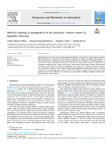Mostrar o rexistro simple do ítem
Machine Learning in Management of Precautionary Closures Caused by Lipophilic Biotoxins
| dc.contributor.author | Molares-Ulloa, Andrés | |
| dc.contributor.author | Fernández-Blanco, Enrique | |
| dc.contributor.author | Pazos, A. | |
| dc.contributor.author | Rivero, Daniel | |
| dc.date.accessioned | 2022-06-29T18:08:44Z | |
| dc.date.available | 2022-06-29T18:08:44Z | |
| dc.date.issued | 2022 | |
| dc.identifier.citation | MOLARES-ULLOA, Andres, FERNANDEZ-BLANCO, Enrique, PAZOS, Alejandro and RIVERO, Daniel, 2022. Machine learning in management of precautionary closures caused by lipophilic biotoxins. Computers and Electronics in Agriculture. 2022. Vol. 197, p. 106956. DOI https://doi.org/10.1016/j.compag.2022.106956 | es_ES |
| dc.identifier.uri | http://hdl.handle.net/2183/31040 | |
| dc.description | Financiado para publicación en acceso aberto: Universidade da Coruña/CISUG | es_ES |
| dc.description.abstract | [Abstract] Mussel farming is one of the most important aquaculture industries. The main risk to mussel farming is harmful algal blooms (HABs), which pose a risk to human consumption. In Galicia, the Spanish main producer of cultivated mussels, the opening and closing of the production areas is controlled by a monitoring program. In addition to the closures resulting from the presence of toxicity exceeding the legal threshold, in the absence of a confirmatory sampling and the existence of risk factors, precautionary closures may be applied. These decisions are made by experts without the support or formalisation of the experience on which they are based. Therefore, this work proposes a predictive model capable of supporting the application of precautionary closures. Achieving sensitivity, accuracy and kappa index values of 97.34%, 91.83% and 0.75 respectively, the kNN algorithm has provided the best results. This allows the creation of a system capable of helping in complex situations where forecast errors are more common. | es_ES |
| dc.description.sponsorship | The authors want to acknowledge the support from INTECMAR, who have provide mostly data for this work and CESGA, who allows to conduct the tests on their installations. Funding for open access charge: Universidade da Coruña/CISUG. This work is supported by the “Collaborative Project in Genomic Data Integration (CICLOGEN) PI17/01826 funded by the Carlos III Health Institute in the context of the Spanish National Plan for Scientific and Technical Research and Innovation 2013–2016 and the European Regional Development Funds (FEDER)—”A way to build Europe.” This project was also supported by the General Directorate of Culture, Education and University Management of Xunta de Galicia (Ref. ED431G/01, ED431D 2017/16), the “Galician Network for Colorectal Cancer Research” (Ref. ED431D 2017/23), Competitive Reference Groups (Ref. ED431C 2018/49) and the Spanish Ministry of Economy and Competitiveness via funding of the unique installation BIOCAI (UNLC08-1E-002, UNLC13-13–3503) and the European Regional Development Funds (FEDER). Enrique Fernandez-Blanco would also like to thank NVidia corp., which granted a GPU used in this work for the preliminary tests | es_ES |
| dc.description.sponsorship | Xunta de Galicia; ED431G/01 | es_ES |
| dc.description.sponsorship | Xunta de Galicia; ED431D 2017/16 | es_ES |
| dc.description.sponsorship | Xunta de Galicia; ED431D 2017/23 | es_ES |
| dc.description.sponsorship | Xunta de Galicia; ED431C 2018/49 | es_ES |
| dc.language.iso | eng | es_ES |
| dc.publisher | Elsevier | es_ES |
| dc.relation | info:eu-repo/grantAgreement/ISCIII/Plan Estatal de Investigación Científica y Técnica y de Innovación 2013–2016/PI17%2F01826/ES/PROYECTO COLABORATIVO DE INTEGRACION DE DATOS GENOMICOS (CICLOGEN). TECNICAS DE DATA MINING Y DOCKING MOLECULAR PARA ANALISIS DE DATOS INTEGRATIVOS EN CANCER DE COLON/ | |
| dc.relation | info:eu-repo/grantAgreement/MEC/Plan Nacional de I+D+i 2008-2011/UNLC08-1E-002/ES/Infraestructura computacional para la Red Gallega de Bioinformática/ | |
| dc.relation | info:eu-repo/grantAgreement/MINECO/Plan Estatal de Investigación Científica y Técnica y de Innovación 2013-2016/UNLC13-1E-3503/ES/ | |
| dc.relation.uri | https://doi.org/10.1016/j.compag.2022.106956 | es_ES |
| dc.rights | Atribución 4.0 Internacional | es_ES |
| dc.rights.uri | http://creativecommons.org/licenses/by/4.0/ | * |
| dc.subject | Machine learning | es_ES |
| dc.subject | Harmful algal blooms | es_ES |
| dc.subject | Mussels | es_ES |
| dc.subject | Aquaculture | es_ES |
| dc.subject | Diarrhoeic shellfish poisoning | es_ES |
| dc.title | Machine Learning in Management of Precautionary Closures Caused by Lipophilic Biotoxins | es_ES |
| dc.type | info:eu-repo/semantics/article | es_ES |
| dc.rights.access | info:eu-repo/semantics/openAccess | es_ES |
| UDC.journalTitle | Computers and Electronics in Agriculture | es_ES |
| UDC.volume | 197 | es_ES |
| UDC.startPage | 106956 | es_ES |
| dc.identifier.doi | 10.1016/j.compag.2022.106956 |
Ficheiros no ítem
Este ítem aparece na(s) seguinte(s) colección(s)
-
GI-RNASA - Artigos [193]






